Watercolor Brush Choices
Watercolor brush choices can take up whole aisles in your local hobby store, but don't let that overwhelm you. This page will help you learn about brush types, brush materials, brush sizes and which to choose for your goals, brands, which brushes are the best, and what will work for you.
Watercolor Brush Types
First, let's talk about watercolor brush types. The most common are the flat brush and the round brushes, and then there's the more specialized fan, filbert, rigger and scrubber brushes. There are, of course, other kinds of brushes, but these are the ones I've used or seen other artists use.
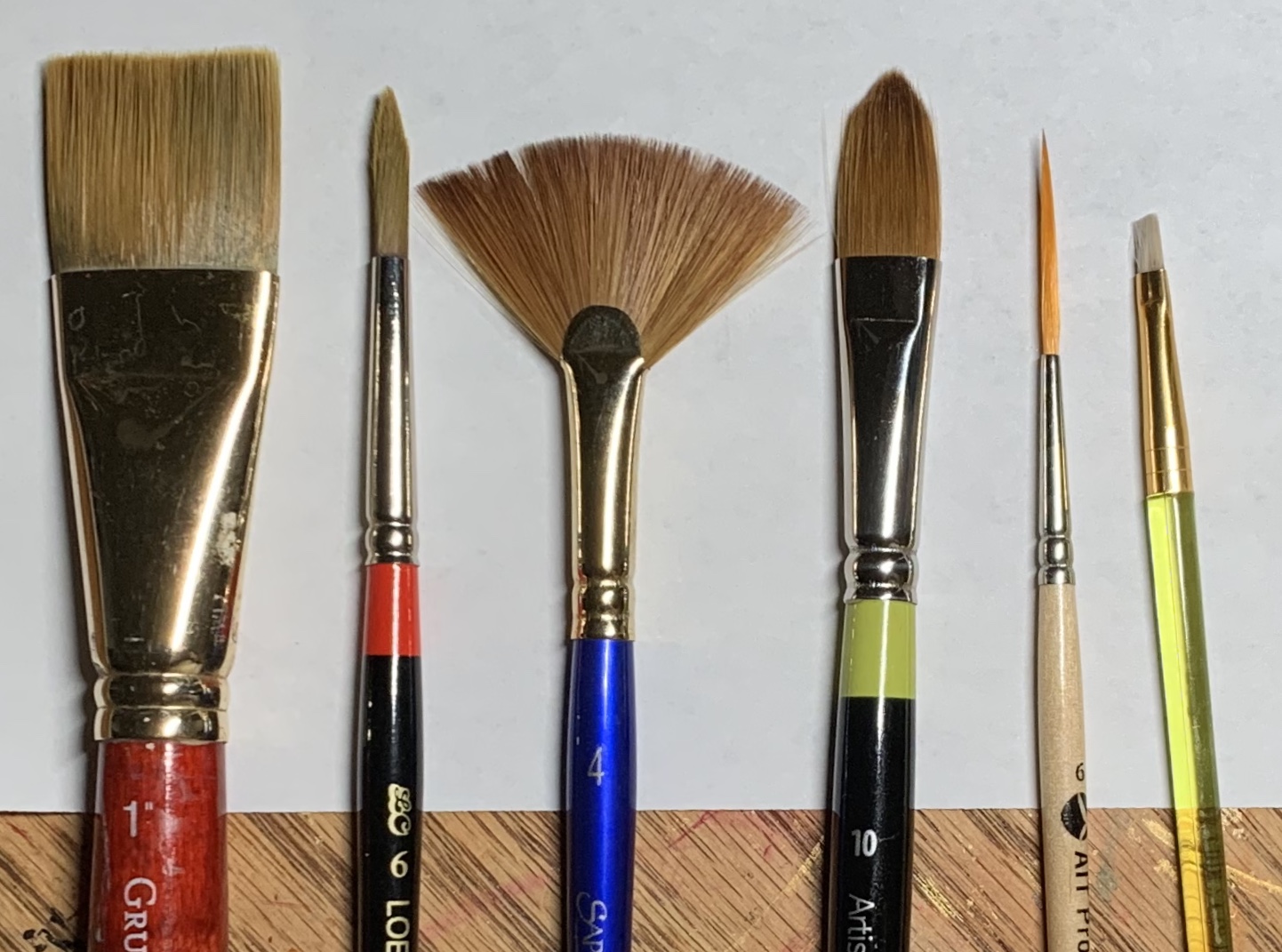 Brushes: flat, round, fan, filbert, rigger and a scrubber brush
Brushes: flat, round, fan, filbert, rigger and a scrubber brush- Flat brushes can be used for painting washes over large areas of paper, or for painting buildings, because they make square or rectangular brush strokes easily. Flats come a range of sizes from 1/8" up to 4" widths. I don't use this type of brush very often. When I do use it, it's usually a wet on wet wash for a sky.
- Round brushes are great for watercolor. They come is sizes from tiny #3X0 to a large #24. These are the brushes that I use the most. The pointed end allows for really detailed strokes while the brush itself can hold quite a bit of water and paint so you don't have to go back to the palette as often.
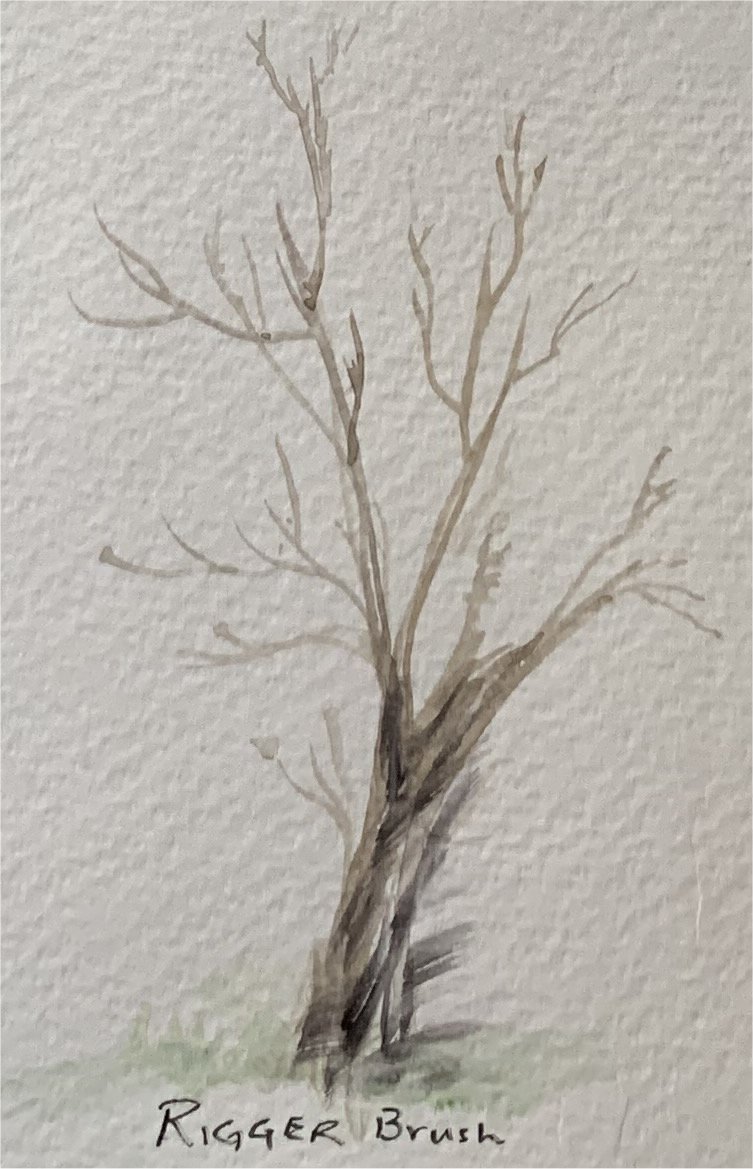
- Fan brushes are useful for landscape paintings. They are great for painting grass, trees or brush/bush details. They come in sizes from a small #1 to #4 and larger.
- Filbert brushes are flat brushes with an oval, sometimes pointed oval tip. These are useful for doing flower or botanical paintings and decorative art. As you apply pressure to the brush, it makes a rounded, soft edge shape, perfect for flower petals.
- Rigger brushes are long narrow brushes useful for painting fine lines, such as the fine branches you might see on a tree in Winter, or the whiskers of an animal. The little painting of the tree on this page is only about 3" by 2", so you can see how detailed you can get with a rigger brush.
- Scrubber brushes are useful for lifting wet paint out of a watercolor painting. I haven't used them, as any brush will help you lift color off the paper.
Brush sizes
Watercolor brush numbers correlate to inch/millimeter sizes, but it depends on the manufacturer. For instance, a round Loew-Cornell #10 might correlate to an inch size of 7/32" or 5.6mm, but in another brand, a #10 brush might be bigger.
I think the best thing for a beginner is to go to the hobby store and spend some time looking at the brushes offered. Think about what kind of paintings you'll be doing and try to choose brushes that you think will help you achieve your artistic goals.
One of the things to consider is how much water and paint a brush will hold. Oil paint and acrylic paint brushes won't work for watercolor because they won't hold a water/paint mixture well.
Along with my favorite professional artists, I think round watercolor brushes with a pointed end in the sizes of 0-8 are the most useful brushes to have. The brush I use the most is a Loew-Cornell #6 round with a nice point. But then I do a lot of detail work in animal portraits. If you plan to do flower paintings, filbert brushes might be the best for you.
If you work on big paintings, a larger round brush like a Joe Miller signature #32 brush or Princeton Neptune Quill #8 might be best. See this video from artist Lorraine Watry for more info on using larger brushes and brush brands.
Brush Fibers
Watercolor brushes are made from either natural fibers such as animal hair or from synthetic fibers. Brushes containing blends of these two materials are also available, and are becoming more popular.
I think one of the most important factors is whether a brush will hold onto its fibers when you start using it. Having to stop a beautiful, smooth wash and pick out a brush hair is annoying to say the least! This is one of the reasons I think it's important to buy good brushes specifically for watercolor painting. The cheap ones are just more aggravating than I can stand.
Here's a picture of what happened when I used a cheap Royal & Langnickel Taklon synthetic brush. I bought them because of the sharp point and because they cost a dollar. (I know, you get what you pay for...)
My hope was that because of the brand name, they wouldn't shed. I was wrong. Grrr. But that point does give great control..
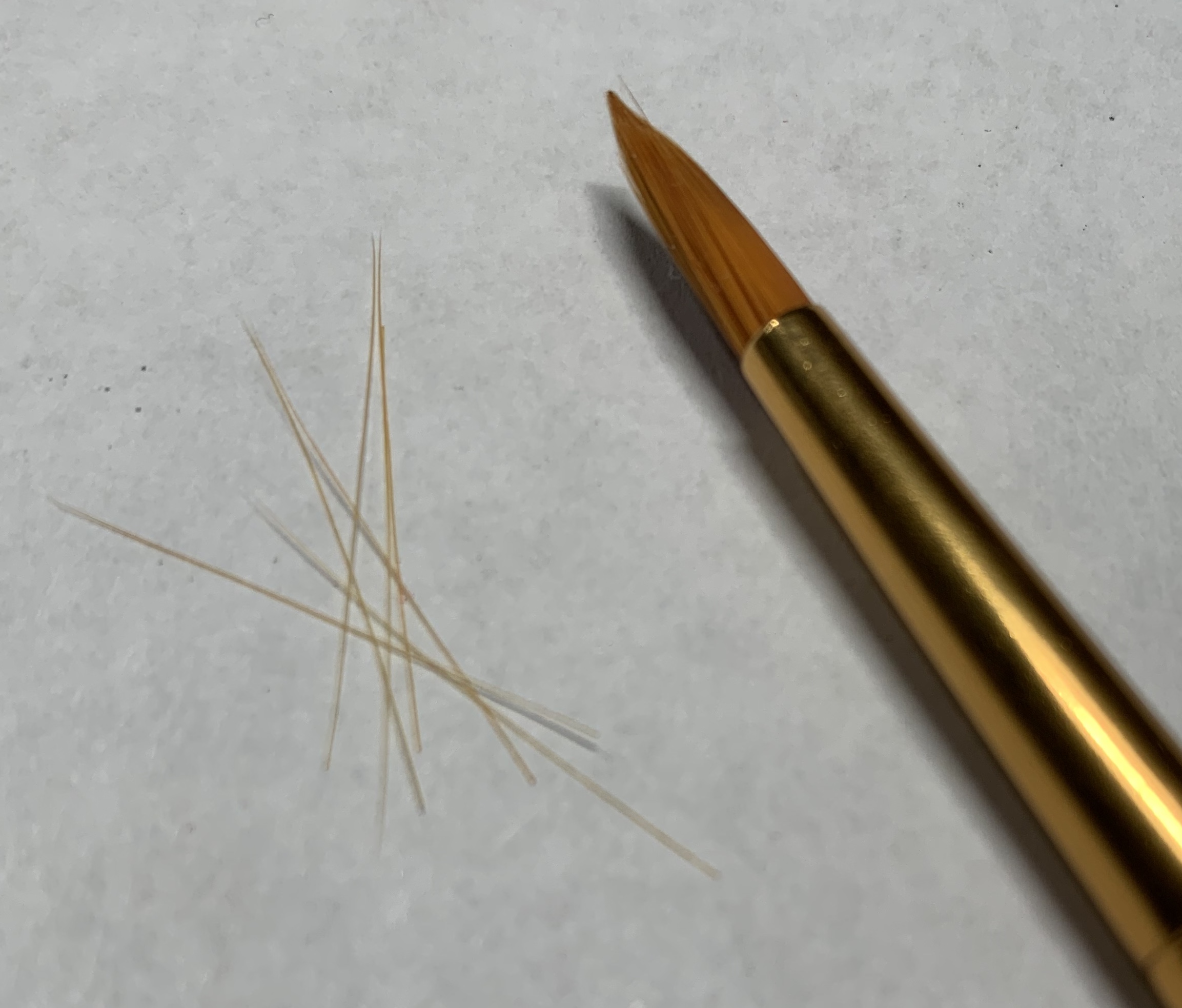 |
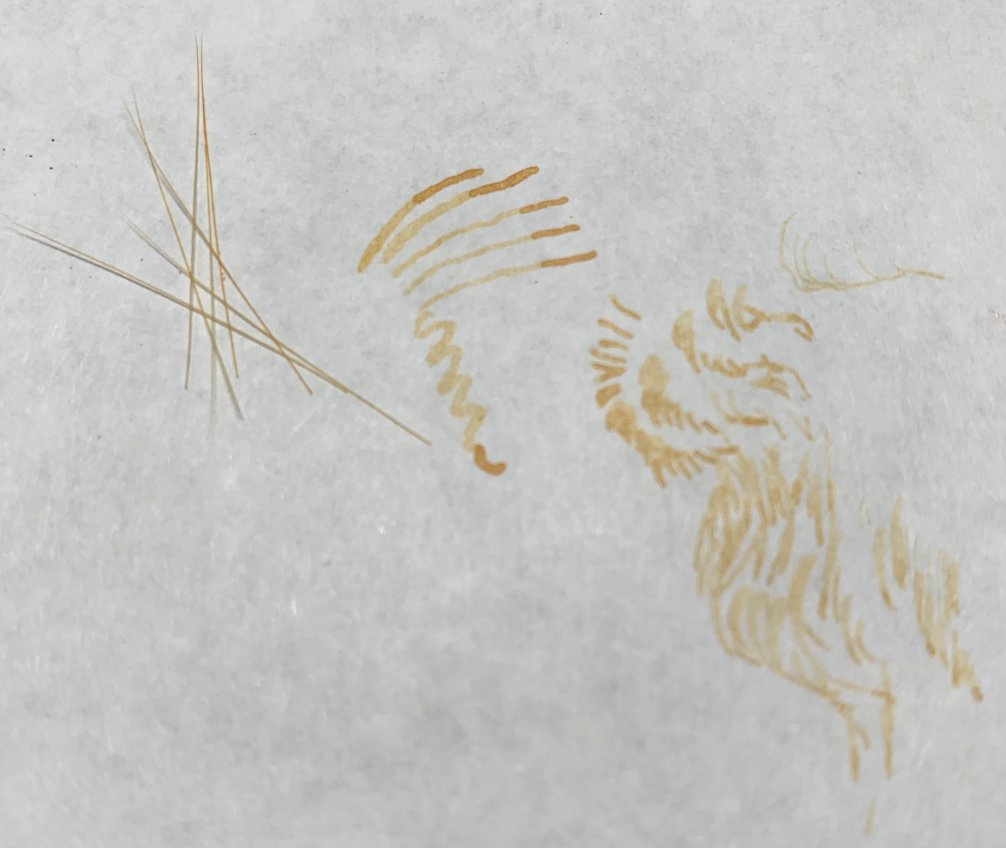 |
Brush Fiber Choices
Watercolor brush quality can be measured somewhat by the price of the brush. Kolinsky natural red sable brushes are the most expensive brushes. Other natural sable brushes are not as expensive, but still cost more than synthetic and other types.
Sables are expensive because of how they are made and the source of the hair, the Siberian weasel. Back in 2012 or so, the US Fish and Wildlife service banned the importing of kolinsky sable brush hair over concerns about species endangerment.
Although the ban had more to do with politics and documentation and not a true species emergency, it has now been lifted. However, knowing that animals have to die to make those natural sable brushes makes me want to choose synthetic fiber ones instead.
Other types of natural fibers used in watercolor brushes include hog's hair, squirrel hair and ox hair. I don't have any in my brush collection, and don't know much about these but I'm sure Google does.
Synthetic fiber brushes (taklon) are smooth and soft but don't hold up as well to rough treatment. In the past, synthetics were less popular, but in 2020, newer technology has really made them contenders in the best-brush race. White taklon brushes are firmer than golden taklon brushes. The golden taklon brushes are designed to act more like sable.
Finally, brushes which utilize a blend of natural hair and synthetic fibers are becoming more popular, and they generally work well for most watercolor techniques.
Taking Care of Your Brushes
If you are careful with your brushes, they can last a long time. Here are some tips on brush care:
- To avoid dulling the brush point on your round brushes, don't push them into the bottom of your water jar. Use more of a swishing motion against the side of the jar instead. In addition, go lightly when picking up and laying on paint. Avoid scrubbing motions, unless you are using a scrubber brush.
- Use your brushes only with watercolor paint.
- If you are using pan paints, wet them before you dip into them with your brush. A spray bottle or a spoon can be used to moisten the pans first too.
- Don't leave your brushes in the water jar for long. Take them out immediately, then blot with a paper towel, shape the bristles back into a point, and lay it flat to dry. You don't want water to run down into the ferrule (the metal part that holds the bristles) and make the wooden handle swell.
- Blotting the brush on a paper towel will also help you see whether it is actually clean. If you see a trace of color on the paper towel, swish the brush again in the water again until you don't. Note that the brush itself might be stained but still be clean and that's normal.
- Once dry, store the brushes tip up, in a heavy container. I bought this ceramic container because of its weight. It will hold those big brushes without tipping over.
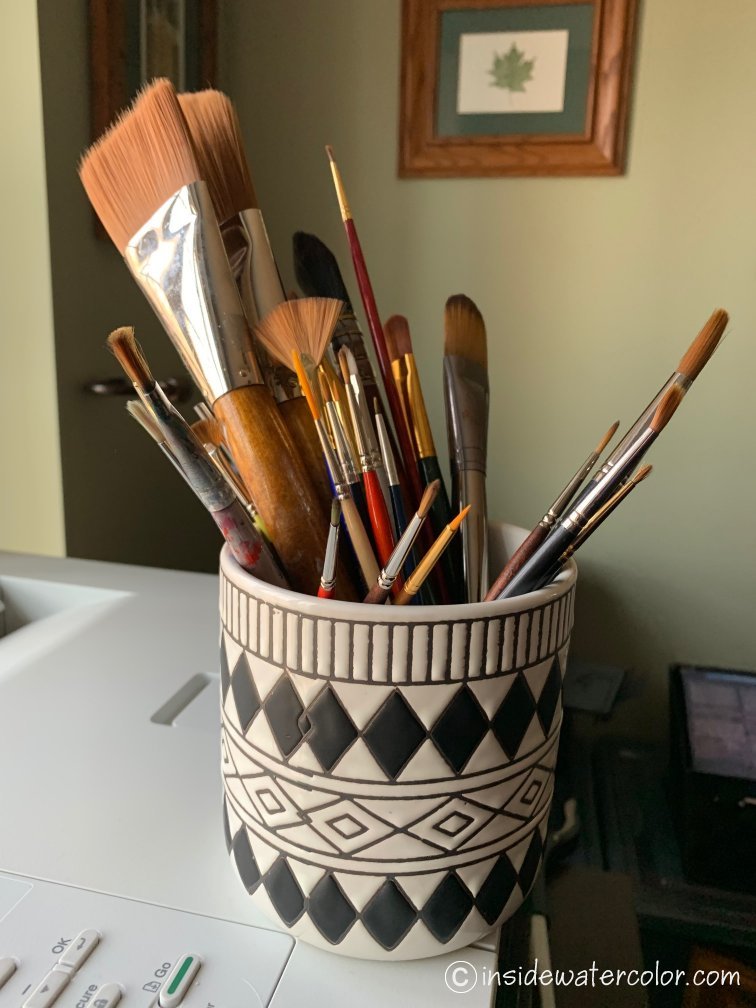 A heavy ceramic container can hold those large brushes
A heavy ceramic container can hold those large brushesWatercolor Brush Brands
Brush brand loyalty is really a subjective, individual choice, driven by individual experience. So I'll just note here which ones I use. The brands that I have in my container include:
- Several Series 7020 round brushes by Loew-Cornell that I use all the time.
- A larger Silver Black Velvet round recommended by artist Lorraine Watry, which holds a lot of water and paint. I don't use it often because I work on smaller, more detailed paintings mostly, but when I do use it, I love it.
- A few imitation sable Raphael detail brushes recommended by Rebecca Rhodes for painting pet portraits. I use these more often.
- Several Robert Simmons brushes which I rarely use.
- A Princeton Neptune Quill brush for wash work in larger areas.
My favorite are the Loew-Cornells. If you need more information on brush choices, search out videos or blogs by your favorite artists and find out what they use and recommend. I found that to be very informative when I was just starting out.
Now you can go yonder, and shop for watercolor brushes with confidence.
If you have any questions, send me a message from my contact page.